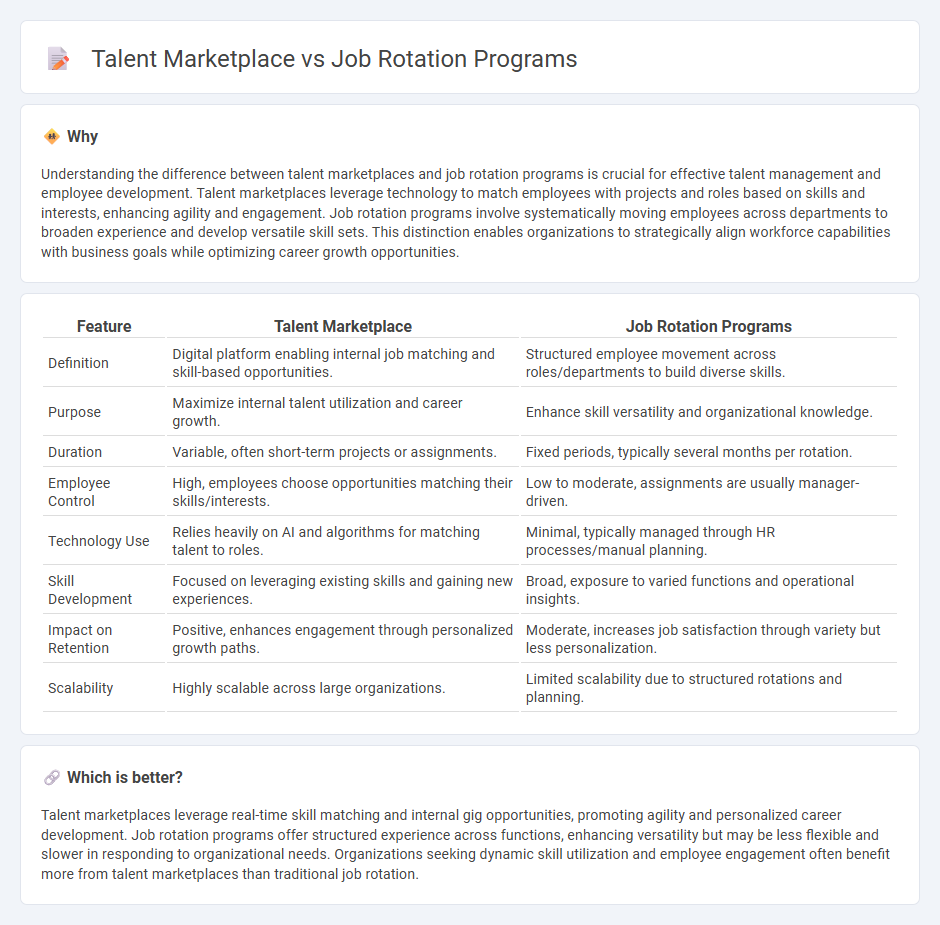
Talent marketplaces leverage AI-driven platforms to match employee skills with internal opportunities, enhancing workforce agility and personalized career growth. Job rotation programs systematically move employees through different roles to develop diverse skill sets and increase organizational flexibility. Explore how these strategies optimize talent management and drive business success.
Why it is important
Understanding the difference between talent marketplaces and job rotation programs is crucial for effective talent management and employee development. Talent marketplaces leverage technology to match employees with projects and roles based on skills and interests, enhancing agility and engagement. Job rotation programs involve systematically moving employees across departments to broaden experience and develop versatile skill sets. This distinction enables organizations to strategically align workforce capabilities with business goals while optimizing career growth opportunities.
Comparison Table
| Feature | Talent Marketplace | Job Rotation Programs |
|---|---|---|
| Definition | Digital platform enabling internal job matching and skill-based opportunities. | Structured employee movement across roles/departments to build diverse skills. |
| Purpose | Maximize internal talent utilization and career growth. | Enhance skill versatility and organizational knowledge. |
| Duration | Variable, often short-term projects or assignments. | Fixed periods, typically several months per rotation. |
| Employee Control | High, employees choose opportunities matching their skills/interests. | Low to moderate, assignments are usually manager-driven. |
| Technology Use | Relies heavily on AI and algorithms for matching talent to roles. | Minimal, typically managed through HR processes/manual planning. |
| Skill Development | Focused on leveraging existing skills and gaining new experiences. | Broad, exposure to varied functions and operational insights. |
| Impact on Retention | Positive, enhances engagement through personalized growth paths. | Moderate, increases job satisfaction through variety but less personalization. |
| Scalability | Highly scalable across large organizations. | Limited scalability due to structured rotations and planning. |
Which is better?
Talent marketplaces leverage real-time skill matching and internal gig opportunities, promoting agility and personalized career development. Job rotation programs offer structured experience across functions, enhancing versatility but may be less flexible and slower in responding to organizational needs. Organizations seeking dynamic skill utilization and employee engagement often benefit more from talent marketplaces than traditional job rotation.
Connection
Talent marketplaces and job rotation programs are interconnected through their shared goal of optimizing workforce agility and enhancing employee skill sets. Talent marketplaces leverage internal mobility tools to match employees with job rotation opportunities that align with their career development and organizational needs. Job rotation programs benefit from talent marketplaces by facilitating seamless transitions across roles, improving employee engagement, and driving knowledge transfer within the company.
Key Terms
Skill Development
Job rotation programs enable employees to gain diverse experience by systematically moving through various roles within an organization, enhancing adaptability and cross-functional skills. Talent marketplaces leverage technology to match employees with projects that align with their skill development goals, fostering agility and personalized growth. Explore how these approaches can strategically advance your workforce capabilities.
Internal Mobility
Job rotation programs facilitate internal mobility by systematically moving employees across different roles to develop diverse skills and gain broad organizational insight. Talent marketplaces leverage AI-driven platforms to match employees with projects and roles aligned with their skills and career goals, enhancing flexibility and engagement. Explore how these approaches optimize internal mobility and drive workforce agility.
Career Pathways
Job rotation programs enhance career pathways by systematically exposing employees to varied roles, which builds versatile skill sets and increases organizational agility. Talent marketplaces leverage AI-driven platforms to match employees with project opportunities aligned to their career aspirations, accelerating personalized growth and internal mobility. Explore how integrating these approaches can optimize career pathways and drive talent development.
Source and External Links
Top 5 Job Rotation Programs for University Business Students - This article covers several job rotation programs for recent college graduates, including Amazon Finance Rotation Program and Capital One Business Rotation Programs.
Job Rotation - This page explains job rotation and provides examples of companies like Amazon, Microsoft, and Allstate that implement such programs for employee development.
Job Rotation: Advantages, Examples, Best practices - This article discusses the benefits and examples of job rotation programs, including those at companies like Abbott and Siemens.
 dowidth.com
dowidth.com